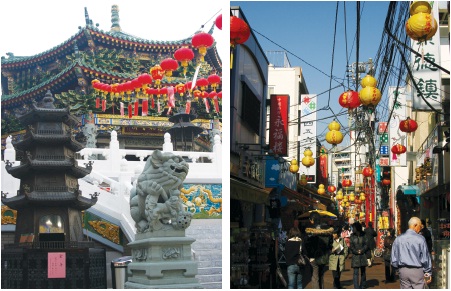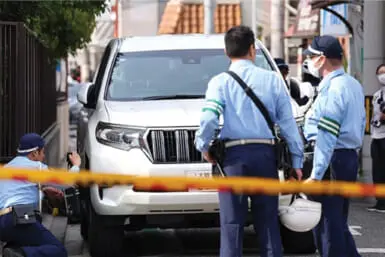by Danielle Tate-Stratton
As I walk into Chinatown in Yokohama, the first thing I notice are the red lanterns decorating the streets and the way the street signs all suddenly have red backgrounds and gold characters. As with any other Chinatown I’ve visited, be it in Toronto, Vancouver, Victoria, Honolulu, or here in Tokyo, turning the corner into Chinatown is like entering another world.
Located just 30km south of Tokyo, or just over half an hour by train from Shibuya station, Chinatown is located in the port town of Yokohama, a city of roughly 3.6 million people and the capital of Kanagawa Prefecture. Yokohama Chinatown has a long history which dates back to 1859, when the first Western merchants came to Yokohama bringing with them Chinese helpers who acted as intermediaries and translators. The Chinese workers settled in one section of the foreigner’s living quarters, and managed to survive there despite challenges like the First Sino-Japanese war, the Kanto earthquake, and World War Two.
Although it isn’t huge, occupying an area of roughly 5,380 square feet (500 square meters) it is packed full of over 500 shops and restaurants. This is a great day trip for couples or families who want to experience China, but can’t swing a trip to the country itself.
Both Chinese and Japanese
intermingle and live
harmoniously, making this a
bit of a multicultural area,
despite its Chinese theme.
I enter through one of the four gates (Pairo), which border the town and are located at the four main points on the compass. The gates are multicolored, and give a strong visual indication that you are entering Chinatown. The gates each also represent a different deity, which are said to constantly endow good fortune on the area. Red and gold hanging lanterns crisscross the streets, and everywhere I turn vendors are roasting chestnuts and proffering them up in small red and gold bags. The smell of the turning and roasting nuts floats across the streets, and to my Western nose, at least, makes me think of Christmas; though these large nuts, which grow in China are obviously an important part of the culture. I take a shiny brown morsel proffered to me as a sample and bite into the warm, dense flesh of the nut’s meat. It is my first roasted chestnut, and I’m surprised at how rich and meaty the flavor is, with just a hint of sweetness. Still, with the vast array of food choices available to me, I decide not to fill up on a whole bag, and continue exploring.
As you might expect, there are many tiny stores selling trinkets and good luck charms, one store sells only panda related objects, a nod to that most favorite of Chinese animals. Dotted along the sidewalks are sandwich boards with large yellow palms on them, enticing people to have their palms read, tempting, but not in English, so not this time. In general, I find that shops are largely signed in Chinese and Japanese, with very little English— suddenly the language barrier that I have been expecting to encounter since arriving in Tokyo has appeared. Even Daska, an obviously tourist oriented museum and food court (more on that later), is strangely devoid of English. Still, don’t let this stop you from visiting Chinatown, it all adds to the exotic appeal of the area.
While I continue to methodically move up and down the streets and alleys, I come across some interesting sights which I can only guess are unique to this area—grocery stores and herbal remedy shops let their wares spill on to the sidewalks, and thin dried fish in a basket find a home beside vegetables and freeze dried herbs, plants, and grains of indeterminate origin. As I pause to photograph the fish, their red scales turning brown and leathery in the surprisingly powerful February sun, a tiny dog trots out of the store and up the stairs to welcome me, proudly wearing a designer sweater to remind me that we are, indeed, not so far from Tokyo. There are other indications of this as well, the clean streets, general lack of hawking from the storekeepers, and shops with neatly wrapped omiyage all lend a Japanese feeling to the place. This makes sense when you consider that of Chinatown’s 3,000–4,000 residents, only a few are actually Chinese, and Japanese residents own many of the shops. Both Chinese and Japanese intermingle and live harmoniously, making this a bit of a multicultural area, despite its Chinese theme.
As lunch time approaches, I decide that the options available in terms of food are just too overwhelming, and decide to let someone else narrow down the choices a little bit by heading to Daska China Museum. This eight story building right in the center of Chinatown is very much what you might expect if you were to see “Disney does China.” They have a two-story marketplace and shop, where there is a nice consolidated selection of goods and prices aren’t unreasonable, but you can certainly buy something more authentic (and probably cheaper) if you head on to the main streets. I persevered through the shop and headed up to the Chinese food theme park on the third, fourth, and fifth floors.
The idea of a food theme park, unique as far as I know to Japan, has been intriguing me since I arrived in Japan, so this seemed like a great chance to try out the idea. Looking a little bit like a Chinese street with multiple vendors, you can buy a huge variety of dishes from noodles to dim sum, to what appeared to be tempura frog legs on a stick. I tried the recommended dish at one of the stands—a noodle bowl with shrimp dumplings and vegetables. Thus fed, I went up to the museum on the seventh and eighth floors (¥300) which I would only recommend if you have a fluent or near fluent Japanese speaker (reader) in your group—the museum focuses on Chinatowns around the world, and has some interesting photos, but the vast majority of the exhibit is written, and all in Japanese. The sixth floor of Daska is a theater that has Chinese entertainment such as acrobatics and music throughout the day (¥800).
Back outside, I cave into the temptation of the street vendors selling dough balls stuffed with meat (or bean paste) steamed in their stacked bamboo containers and buy a selection of five different dim sum style morsels (¥600). Included in the set is a small white dough ball, with the distinctively shaped top and pleated sides filled with pork, and a tiny, perfectly wrapped bundle of meat and rice tied up in a large bamboo leaf. Each piece is a perfect size to try, and I’m able to test the variety of street food without feeling over stuffed.
On my way out of the area, I stop by one last breathtaking site—just across the street from Daska is the Yokohama Ma Zhu Miao, where Ma Zhu, “the Holy Mother of Heaven,” the goddess who is said to protect commercial ships from disasters and plagues is celebrated. Enter through an ornate gate, and see the temple, hanging lanterns, small temples, statues, and a dragon boat canoe. As with the rest of the area, bring your camera!
Of course, with the Chinese New Year coming up on Feb. 18, there are special events coming up in Chinatown. Highlights include dancing and songs at the Rose Hotel from 7pm on Feb. 17, a countdown to New Year’s on Feb. 17 at midnight, a lion dance, dragon dance Feb. 18 (the first day of the lunar calendar), a parade on Feb. 20 from 4pm to 5:30pm, an exhibit of Children’s artwork at Chinatown 80 from Mar. 5 to Mar. 18 and more. For information about specific events, visit www.chinatown.or.jp (Japanese only), or contact the Japan National Tourist Organization at 03-3201-3331 for more information.
To get to Chinatown from Shibuya station, take the Tokyu Toyoko Line to Motomachi Chukagai station, which directly serves Chinatown. A limited or commuter express train will take approximately 30 minutes and costs ¥460 one way. From Shinjuku, take the JR Shonan–Shinjuku line to Yokohama (special rapid takes 27 minutes and costs ¥540) and transfer to the Minatomirai Line to get to Motomachi Chukagai (a three minute trip on the rapid train costs ¥200).
There are several websites with detailed information about Chinatown and the surrounding area. The Japan National Tourist Organization (www.jnto.go.jp) has useful pages about the area, including a seven-page pdf file that includes maps, listings, and the names and phone numbers of four local information offices. If you plan in advance, the JNTO’s Goodwill Guide Groups program matches up tourists with people who are learning English and want to practice by guiding you around the area. The tours are free, but you generally need to book a week in advance, and you must cover any of your guide’s expenses. Visit www.jnto.go.jp/eng/GJ for more information about the program.
The Yokohama Convention & Visitors Bureau website also has access information, photos, tours, and listings at www.welcome.city.yokohama.jp/eng/tourism.










